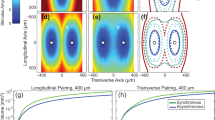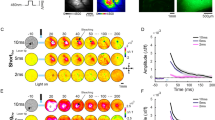Abstract
Efforts on selective neural stimulation have concentrated on segregating axons based on their size and geometry. Nonetheless, axons of the white matter or peripheral nerves may also differ in their electrophysiological properties. The primary objective of this study was to investigate the possibility of selective activation of axons by leveraging an assumed level of diversity in passive (Cm & Gleak) and active membrane properties (Ktemp & Gnamax). First, the stimulus waveforms with hyperpolarizing (HPP) and depolarizing pre-pulsing (DPP) were tested on selectivity in a local membrane model. The default value of membrane capacitance (Cm) was found to play a critical role in sensitivity of the chronaxie time (Chr) and rheobase (Rhe) to variations of all the four membrane parameters. Decreasing the default value of Cm, and thus the passive time constant of the membrane, amplified the sensitivity to the active parameters, Ktemp and GNamax, on Chr. The HPP waveform could selectively activate neurons even if they were diversified by membrane leakage (Gleak) only, and produced higher selectivity than DPP when parameters are varied in pairs. Selectivity measures were larger when the passive parameters (Cm & Gleak) were varied together, compared to the active parameters. Second, this novel mechanism of selectivity was investigated with non-rectangular waveforms for the stimulating phase (and HPP) in the same local membrane model. Simulation results suggest that Kt2 is the most selective waveform followed by Linear and Gaussian waveforms. Traditional rectangular pulse was among the least selective of all. Finally, a compartmental axon model confirmed the main findings of the local model that Kt2 is the most selective, but rank ordered the other waveforms differently. These results suggest a potentially novel mechanism of stimulation selectivity, leveraging electrophysiological variations in membrane properties, that can lead to various neural prosthetic applications.


















Similar content being viewed by others
References
Adamson, C. L., Reid, M. A., & Davis, R. L. (2002a). Opposite actions of brain-derived neurotrophic factor and neurotrophin-3 on firing features and ion channel composition of murine spiral ganglion neurons. Journal of Neuroscience, 22(4), 1385–1396.
Adamson, C. L., et al. (2002b). Firing features and potassium channel content of murine spiral ganglion neurons vary with cochlear location. The Journal of Comparative Neurology, 447(4), 331–350.
Bostock, H. (1983). The strength-duration relationship for excitation of myelinated nerve: Computed dependence on membrane parameters. Journal of Physiology, 341, 59–74.
Carp, J. S. (1992). Physiological properties of primate lumbar motoneurons. Journal of Neurophysiology, 68(4), 1121–1132.
Chiu, S. Y., et al. (1979). A quantitative description of membrane currents in rabbit myelinated nerve. Journal of Physiology, 292, 149–166.
Cho, R. H., et al. (2004a). Intracellularly labeled pyramidal neurons in the cortical areas projecting to the spinal cord. I. Electrophysiological properties of pyramidal neurons. Neuroscience Research, 50(4), 381–94.
Cho, R. H., et al. (2004b). Intracellularly labeled pyramidal neurons in the cortical areas projecting to the spinal cord. II. Intra- and juxta-columnar projection of pyramidal neurons to corticospinal neurons. Neuroscience Research, 50(4), 395–410.
Cohen, I., Attwell, D., & Strichartz, G. (1981). The dependence of the maximum rate of rise of the action potential upstroke on membrane properties. Proceedings of the Royal Society of London. Series B: Biological Sciences, 214(1194), 85–98.
De Schutter, E., & Bower, J. M. (1994a). An active membrane model of the cerebellar Purkinje cell II. Simulation of Synaptic Responses. Journal of Neurophysiology, 71(1), 401–419.
De Schutter, E., Bower, J. M. (1994b). An active membrane model of the cerebellar Purkinje cell. I. Simulation of current clamps in slice. Journal of Neurophysiology, 71(1), 375–400.
Deurloo, K. E., Holsheimer, J., & Bergveld, P. (2001). The effect of subthreshold prepulses on the recruitment order in a nerve trunk analyzed in a simple and a realistic volume conductor model. Biological Cybernetics, 85(4), 281–291.
Eccles, J. C., Eccles, R. M., & Lundberg, A. (1958). The action potentials of the alpha motoneurones supplying fast and slow muscles. Journal of Physiology, 142(2), 275–291.
Espay, A. J., et al. (2016). Technology in Parkinson’s disease: Challenges and opportunities. Movement Disorders, 31(9), 1272–1282.
Goldman, L., & Albus, J. S. (1968). Computation of impulse conduction in myelinated fibers; theoretical basis of the velocity-diameter relation. Biophysical Journal, 8(5), 596–607.
Gorman, P. H., & Mortimer, J. T. (1983). The effect of stimulus parameters on the recruitment characteristics of direct nerve stimulation. IEEE Transactions on Biomedical Engineering, 30(7), 407–414.
Grill, W. M., & Mortimer, J. T. (1995). Stimulus waveforms for selective neural stimulation. IEEE Engineering in Medicine and Biology Magazine, 14(4), 375–385.
Grill, W. M., & Mortimer, J. T. (1997). Inversion of the current-distance relationship by transient depolarization. IEEE Transactions on Biomedical Engineering, 44(1), 1–9.
Grill, W. M. (2015). Model-based analysis and design of waveforms for efficient neural stimulation. Progress in Brain Research, 222, 147–162.
Hodgkin, A. L., & Huxley, A. F. (1952). A quantitative description of membrane current and its application to conduction and excitation in nerve. Journal of Physiology, 117(4), 500–544.
Jaeger, D., & Bower, J. M. (1999). Synaptic control of spiking in cerebellar Purkinje cells: Dynamic current clamp based on model conductances. Journal of Neuroscience, 19(14), 6090–6101.
Johnson, M. D., et al. (2013). Neuromodulation for brain disorders: Challenges and opportunities. IEEE Transactions on Biomedical Engineering, 60(3), 610–624.
Kiernan, M. C., Cikurel, K., & Bostock, H. (2001). Effects of temperature on the excitability properties of human motor axons. Brain, 124(Pt 4), 816–825.
McKay, C. M., & McDermott, H. J. (1998). Loudness perception with pulsatile electrical stimulation: The effect of interpulse intervals. Journal of the Acoustical Society of America, 104(2 Pt 1), 1061–1074.
McIntyre, C. C., & Grill, W. M. (2000). Selective microstimulation of central nervous system neurons. Annals of Biomedical Engineering, 28(3), 219–233.
Mitra, P., & Brownstone, R. M. (2012). An in vitro spinal cord slice preparation for recording from lumbar motoneurons of the adult mouse. Journal of Neurophysiology, 107(2), 728–741.
Motz, H., & Rattay, F. (1986). A study of the application of the Hodgkin-Huxley and the Frankenhaeuser-Huxley model for electrostimulation of the acoustic nerve. Neuroscience, 18(3), 699–712.
Rattay, F. (1995). Modelling of the excitation and the propagation of nerve impulses by natural and artificial stimulations. Mathematics and Computers in Simulation, 39(5), 589–595.
Schwarz, J. R., & Eikhof, G. (1987). Na currents and action potentials in rat myelinated nerve fibres at 20 and 37 degrees C. Pflugers Archiv. European Journal of Physiology, 409(6), 569–577.
Schwarz, J. R., Reid, G., & Bostock, H. (1995). Action potentials and membrane currents in the human node of Ranvier. Pflugers Archiv. European Journal of Physiology, 430(2), 283–292.
Smit, J. E., Hanekom, T., & Hanekom, J. J. (2009). Modelled temperature-dependent excitability behaviour of a generalised human peripheral sensory nerve fibre. Biological Cybernetics, 101(2), 115–130.
Stifani, N. (2014). Motor neurons and the generation of spinal motor neuron diversity. Frontiers in Cellular Neuroscience, 8, 293.
Sweeney, J. D., Mortimer, J. T., Durand, D. (1987). Modeling of Mammalina Myelinated Nerve for Functional Neuromuscular Stimulation. IEEE.
van Aerde, K. I., & Feldmeyer, D. (2015). Morphological and physiological characterization of pyramidal neuron subtypes in rat medial prefrontal cortex. Cerebral Cortex, 25(3), 788–805.
Warman, E. N., Grill, W. M., & Durand, D. (1992). Modeling the effects of electric fields on nerve fibers: Determination of excitation thresholds. IEEE Transactions on Biomedical Engineering, 39(12), 1244–1254.
Walton, M., & Fozzard, H. A. (1979). The relation of Vmax to INa, GNa, and h infinity in a model of the cardiac Purkinje fiber. Biophysical Journal, 25(3), 407–420.
Zhang, Y., et al. (2014). Effects of maximal sodium and potassium conductance on the stability of Hodgkin-Huxley model. Computational and Mathematical Methods in Medicine, 761907.
Author information
Authors and Affiliations
Corresponding author
Ethics declarations
Conflict of interest
The authors declare that they have no conflict of interest.
Additional information
Action Editor: Gaute T. Einevoll
Publisher's Note
Springer Nature remains neutral with regard to jurisdictional claims in published maps and institutional affiliations.
Supplementary information
Below is the link to the electronic supplementary material.
Rights and permissions
About this article
Cite this article
Ghobreal, B., Nadim, F. & Sahin, M. Selective neural stimulation by leveraging electrophysiological differentiation and using pre-pulsing and non-rectangular waveforms. J Comput Neurosci 50, 313–330 (2022). https://doi.org/10.1007/s10827-022-00818-8
Received:
Revised:
Accepted:
Published:
Issue Date:
DOI: https://doi.org/10.1007/s10827-022-00818-8




